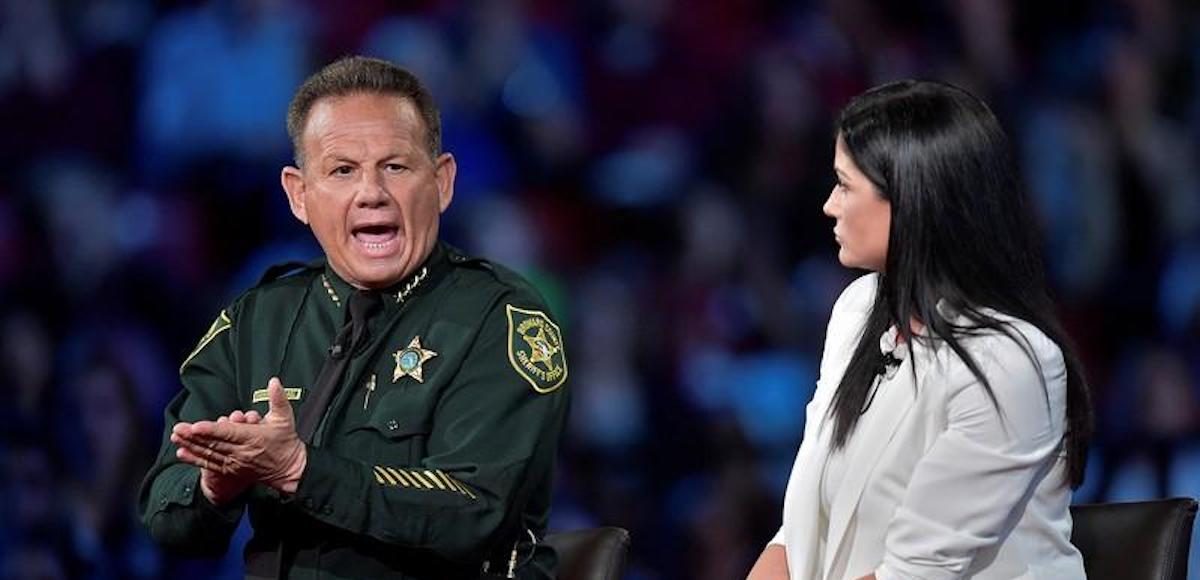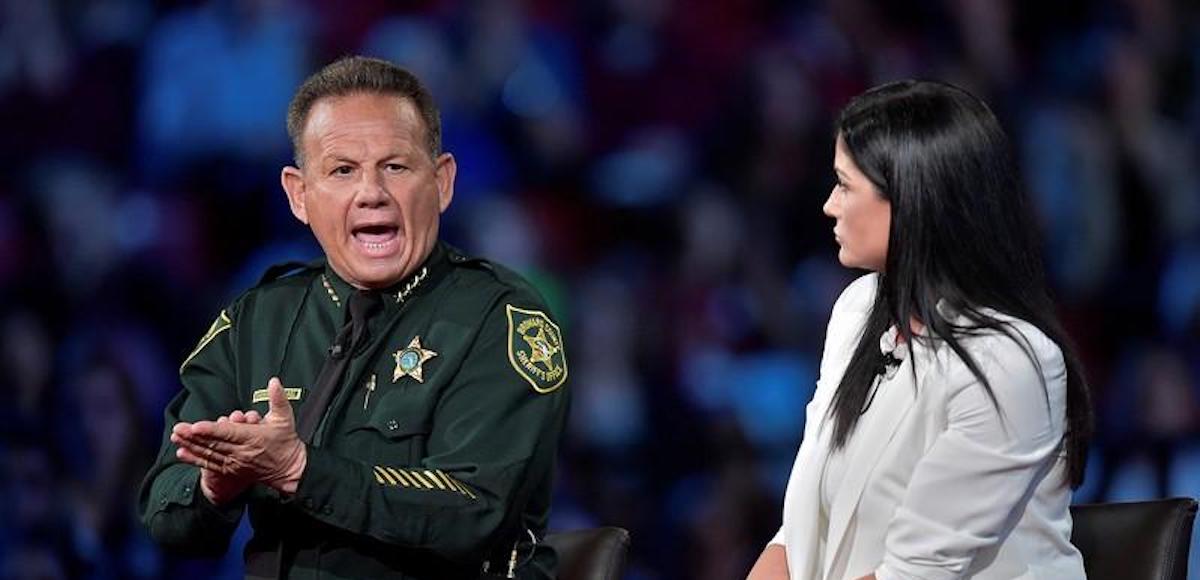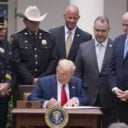
There Is Academic, Law Enforcement Consensus That Media Is the Contagion, Not the Solution (At Least Not Yet)

Broward Sheriff Scott Israel, left, shouts at National Rifle Association (NRA) Spokesperson Dana Loesch during a CNN town hall meeting, at the BB&T Center, in Sunrise, Florida, U.S. February 21, 2018. (Photo: Reuters)
Following the shooting at Marjory Stoneman Douglas High School in Parkland, Florida, CNN held a townhall. They invited the now-embattled Broward County Sheriff Scott Israel, a known gun control activist, gun control-supporting members of the community and Dana Loesch, a spokesperson for the National Rifle Association (NRA).
The perpetrators name, which will not be mentioned here, was spoken aloud countless times. CNN put its political agenda first, and disguised it as a townhall meant to further the discussion on school safety.
Given the wealth of data collected by academics and law enforcement agencies studying the phenomena, it’s time for Americans to demand media outlets acknowledge their role in school shootings and mass killings. It’s time for Americans to demand they take responsibility and proactive measures to minimize the likelihood of a prior mass killing inducing another.
Before we get into the data, let’s first define what it is we’re talking about and set a few parameters.
A “mass shooting” is properly defined as a public shooting in which one or more perpetrators with a firearm murders at least 4 victims. Researchers in the field have argued the modern phenomenon of mass shootings began in 1966 with the tragic incident at the University of Texas.
It’s also important to first note that the data used in these studies may vary. For instance, one study may have isolated 18- to 29-year-olds, while others reviewed all age groups for potential copycats. Some studies included suicidal perpetrators, while others did not.
Nevertheless, the academic and law enforcement consensus is clear: the media inspires copycats in school shootings and induces mass murder events. The media is the contagion, not the solution — at least not yet.
That being said, not all media outlets have refused to take responsibility. Much to their credit, Mark Follman and Becca Andrews at Mother Jones have done great work documenting the “Columbine effect.”
On April 20, 1999, two teenage boys fatally shot 13 people and injured 24 others at Columbine High School in Littleton, Colorado. The Mother Jones investigation found the shooting inspired at least 74 plots or attacks across 30 states.[1] In at least 14 cases, Columbine copycats plotted their attacks on the anniversary of the original massacre.
“Individuals in 13 cases indicated that their goal was to outdo the Columbine body count,” they wrote. “In at least 10 cases, the suspects and attackers referred to the pair who struck in 1999, [name redacted] and [name redacted], as heroes, idols, martyrs, or God. And at least three plotters made pilgrimages to Columbine High School from other states.”
Since Columbine, the Federal Bureau of Investigation (FBI) has been devoted to researching the potential causes of copycats. Supervisory Special Agent Andre Simons previously led a team of agents and psychology experts that researched more than 400 of these cases.[2]
“They do this to claim credit and to articulate the grievance behind the attack,” Mr. Simons told Mr. Follman. “And we believe they do it to heighten the media attention that will be given to them, the infamy and notoriety they believe they’ll derive from the event.”
In response, the FBI proposed the “Don’t Name Them” campaign. Similarly, Tom and Caren Teves — whose son Alex was among the 12 killed at a movie theatre in Aurora, Colorado, in 2012 — proposed the “No Notoriety” campaign.
Academic research corroborates the assessment of law enforcement agencies, though the “Columbine effect” is referred to as a contagion.
Contagion in Mass Killings and School Shootings published in 2015 concluded there was “significant evidence that mass killings involving firearms are incented by similar events in the immediate past.”[3]
On average, this temporary increase in probability lasts 13 days, and each incident incites at least 0.30 new incidents (p = 0.0015). We also find significant evidence of contagion in school shootings, for which an incident is contagious for an average of 13 days, and incites an average of at least 0.22 new incidents (p = 0.0001).
Worth noting, this study excluded foiled plots where individuals were caught actively planning a shooting, but had not yet carried out their plan. They also stress that it is difficult to accurately assess how high of a percentage media-induced copycats represent because so many of the perpetrators kill themselves.
Mass Killings in the United States from 2006 to 2013: Social Contagion or Random Clusters? published in 2017 questioned the short-term contagion. However, the study warned of “longer term copycat effects.”[4] Indeed, many perpetrators cited events that took place before they were even born.
Reducing Media-Induced Mass Killings: Lessons From Suicide Prevention published most recently in 2018 was even more conclusive.[5]
Generalized imitation requires the presence of some model to prompt imitation, and we suggest media reporting methods as a prominent model inspiring future mass killings.
James N. Meindl and Jonathan W. Ivy, the authors of the study, go on to “evaluate media reporting guidelines” and imitational behaviors “to identify reactive and proactive strategies that could minimize the likelihood of one mass killing inducing another.”
Yet another study, Don’t Name Them, Don’t Show Them, But Report Everything Else, not only found that media-induced events are real but also more deadly.[6]
These fame-seeking offenders are particularly dangerous because they kill and wound significantly more victims than other active shooters, they often compete for attention by attempting to maximize victim fatalities, and they can inspire contagion and copycat effects. However, if the media changes how they cover mass shooters, they may be able to deny many offenders the attention they seek and deter some future perpetrators from attacking.
These findings have palpable implications. Big Media, a term we use at People’s Pundit Daily (PPD) to refer to the cartel of corporate media outlets, have always been supportive of the gun control agenda. That not-so subtle support generally took the form of an anti-NRA or anti-Second Amendment story-telling narrative.
But in recent years it has transformed into “production news” and blatant activism, as we saw with the CNN townhall. In their desire to strike at gun rights while the iron is hot, they ignore all impact their coverage may have on deeply alienated students prone to committing these acts, let alone the causes of their alienation.
Americans must start to ask themselves whether they will allow Big Media to put their political agenda over the safety of our children and loved ones. In turn, Big Media executives and journalists must start to ask themselves whether their political agenda is more important than their children and loved ones.
Footnotes
- How Columbine Spawned Dozens of Copycats, by Mark Follman and Becca Andrews. Mother Jones (October 5, 2015)
- How the Media Inspires Mass Shooters, by Mark Follman. Mother Jones (October 6, 2015)
- Contagion in Mass Killings and School Shootings, by Sherry Towers , Andres Gomez-Lievano, Maryam Khan, Anuj Mubayi, Carlos Castillo-Chavez. PLOS ONE (July 2, 2015)
- Mass Killings in the United States from 2006 to 2013: Social Contagion or Random Clusters?, by Adam Lankford PhD and Sara Tomek PhD. The University of Alabama Tuscaloosa & Wiley/Blackwell (July 20, 2017)
- Reducing Media-Induced Mass Killings: Lessons From Suicide Prevention, by James N. Meindl and Jonathan W. Ivy. American Behavioral Scientist (February 3, 2018)
- Don’t Name Them, Don’t Show Them, But Report Everything Else: A Pragmatic Proposal for Denying Mass Killers the Attention They Seek and Deterring Future Offenders, by Adam Lankford and Eric Madfis. American Behavioral Scientist (September 5, 2017)








Daisy Clover? / March 20, 2018
That’s why they broadcast them 24/7.
It ferrets out/emboldens crazies so that they then go on a nut… https://t.co/DZWnGJbeoq
/
Craig Gleason / March 20, 2018
Alwso distort the facts about them.
/
Jef Brads / March 20, 2018
https://t.co/S2KKbVY5QT
/